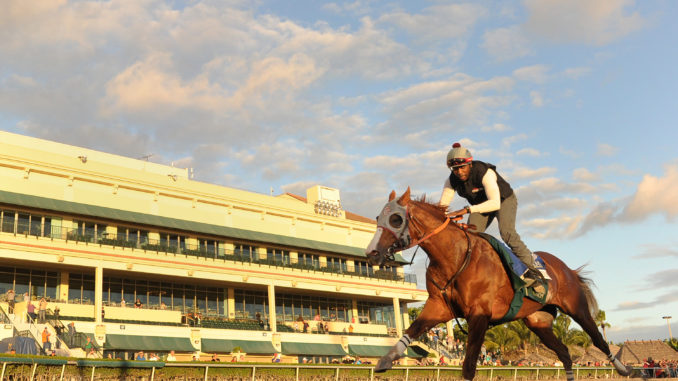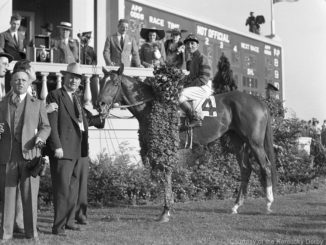
Originally Published June 10, 2014
Is the Triple Crown anachronistic?
Even before California Chrome’s bid for the Triple Crown was halted in last
weekend’s Belmont Stakes, the 12th spoiled attempt since the series was last
swept in 1978, a significant and vocal segment of those within and outside the
Thoroughbred industry began to publicly clamor for a change in the spacing
between the three races.
Despite the general public’s apparent satisfaction with the current five-week
Triple Crown window, as demonstrated by explosive results in on-track
attendance, handle, and television ratings this year, the debate is likely to
continue for the foreseeable future.
When a Triple Crown is not on the line in the Belmont, the Preakness is
typically the second most attended, wagered-on and watched horse race in the
U.S. However, Maryland Jockey Club executives now advocate more time between the
Kentucky Derby and the Preakness, not to improve a seemingly unbroken Preakness
but to bolster undercard stakes with conditions similar to races run on Kentucky
Derby and Belmont Days that are comparatively under funded.
Similarly self-centered, and more obtuse, were the criticisms from California
Chrome’s co-owner, Steve Coburn, who seemingly has no problem with the current
Triple Crown spacing but with who is eligible to run in the three events.
Unhappy that his colt was defeated by horses who bypassed either or both the
Kentucky Derby and Preakness (the reasons do not matter), Coburn essentially
believes that a maximum pool of 20 horses — those that start in the Kentucky
Derby — are the only ones that should remain eligible to run in the remaining
classics.
This uninformed view overlooks the fact that the three races were
independently created in the 1860s and 1870s, were not widely viewed as a
unified series until the 1930s, and had different nominating procedures until
the 1980s. For more than a century there was nothing tangibly linking the three
races into any sort of a cohesive unit except in the minds of the public. They
were, and in many respects remain, stand-alone entities open to the world.
For someone who has had difficulty coming up with real analogies, Coburn’s
richly ironic views of exclusivity would preclude someone from teeing up against
a grand-slam seeking Tiger Woods in the PGA Championship unless he had made the
cut in the three previous golf majors. It would stop in the tracks a U.S. Open
tennis contender hoping to halt Serena Williams’ chance at history because she
missed Wimbledon due to injury.
More articulate but similarly misguided critics of the current format — two
weeks between the Kentucky Derby and Preakness, three weeks between the
Preakness and Belmont — argue that the current spacing is anachronistic in an
era when horses are not as stoutly bred and generally require more time between
starts, and that the spacing of the Triple Crown races was not uniform when
mass communication was restricted to radio, movie house newsreels, and
newspapers — a time most of us remember fondly.
The basic argument against the latter point, which I’ve written previously,
is that the three horses who accomplished the feat in the color television era
— Secretariat, Seattle Slew and Affirmed — did so under the conditions in
existence today and alone are considered the yardstick by which all future
Triple Crown winners will be judged. Any deviation from the course those three
took to attain the goal would make it impossible for a future Triple Crown
winner to be looked at in the same vein.
The arguments regarding breeding and modern training methods actually raise a
question not many are asking: Is the concept of having a Triple Crown itself
anachronistic?
The mother country of Thoroughbred racing, England, has its own Triple Crown
consisting of the Two Thousand Guineas, Derby and St Leger. Routinely won in the
late 19th and early 20th centuries, the series has not been swept since 1970 and
only twice since the First World War. Since Nijinsky’s Triple Crown sweep in
1970, three horses have won the first two legs but only Camelot (2012) even
attempted to win the St Leger (he finished second).
The calendar placement, distances and locations of the three legs of the
English Triple Crown have remained virtually unchanged for decades. The only
material difference is that three races are now run on Saturdays rather than
mid-week.
Arguably the main reason why the English Triple Crown has not been won more
frequently is the breeding of Thoroughbreds long ago became specialized. Horses
are simply not created and subsequently trained to excel at distances ranging
from one mile to 1 3/4 miles. Though there is some overlap, European-based
Thoroughbreds are generally divided into milers, middle-distance performers, and
stayers.
While the popularity of racing throughout the Western world has declined
relative to other spectator sports, in the case of England it isn’t due to a
lack of a Triple Crown winner. The series is still there in its same format and
times, but except for the occasional one-off every 40 years or so is no longer
considered a goal worth pursuing by most horsemen.
American racing, centered for the longest time in the general public’s
consciousness around the Triple Crown, is obviously different. It is the one
event that attracts a mainstream audience to the sport. That’s unfortunate in
some respects if the modern three-year-old Thoroughbred is not physiologically
equipped to and/or handcuffed by regimented training practices to succeed in
three races over the span of five weeks.
The Triple Crown has come fairly close to being swept multiple times in the
past 36 years. However, there is no evidence to suggest that the breeding and
training methods arguably at the heart of the drought are likely to change. More
near-misses are what the general audience will probably have to become
accustomed to.
If that is indeed the case, rather than fiddle with the dates of the series,
perhaps the importance of sweeping the Triple Crown should be allowed to become
a relic of a glorious but bygone era.
That would be a difficult undertaking to be sure, but no one seriously
believes anymore that having a horse win the Triple Crown would give the sport
much more than a minor, and relatively short, boost of popularity with the
general public. At any rate, modern economics dictate that colts more
fashionably bred than California Chrome who happen to win the Triple Crown would
be whisked off to stud in a heartbeat. The Triple Crown sweep, thus, is a
potential deterrent to greater exposure: an end rather than a means to an end.
The Thoroughbred sport has been enriched by the widespread popularity of such
greats as Seabiscuit, Native Dancer, Kelso, Forego, Dr. Fager, John Henry,
Cigar, and Zenyatta. None were Triple Crown winners and some never competed in any
of the classics. Their examples show there is way for racing to find a mass
audience while not relying so heavily on immature three-year-olds and their
quest for a goal increasingly unattainable through no fault of their own.
Leave the Triple Crown as is and there to be won for those so inclined to
try, but let’s also work on shifting the foundation of the sport’s popularity
with the general public away from a window so narrow no one can see the forest
for the trees.



